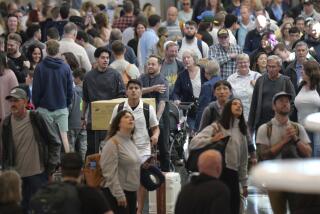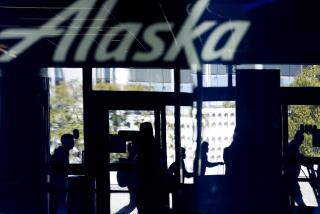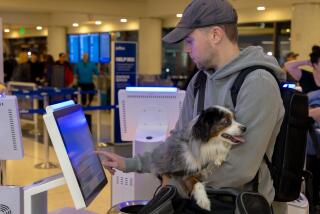Airlines Buckle Down to Handle Holiday Crowds
NEW YORK — It’s beginning to look a lot like Christmas at the nation’s airports. There are the usual: Santas on their sleighs, snow flakes hanging from rafters and plenty of lighted trees and tinsel.
Soon the airlines will begin serving their passengers egg nog, turkey, pumpkin pie and millions of candy canes. Now and then a flight attendant or ticket agent will run up and down the aisle of a plane or in the airport dressed as Mr. or Mrs. Claus.
But that’s about as far as the Christmas spirit goes for the airlines. The business of getting America home for the holidays is not as profitable as it might seem. And it’s a time when the carriers spend extra money making sure that hassles are kept to a minimum.
“The last thing you want to do is mess someone up going home for Christmas,” said Michael W. Gunn, American Airlines senior vice president for marketing. “It’s terrible time to have problems.”
The nation’s airlines are expecting more than 22 million holiday passengers, a record for the period between this weekend and Jan. 2. Suddenly, they find themselves without a steady stream of business travelers and are confronted instead with bargain-fare, baggage-laden college students, soldiers and vacationers.
Unlike their more reliable regular customers, these passengers tend to book two or three reservations each, take one flight but never cancel the others and show up at the airport with an armful of gifts too big to put under any airline seat. Throw in a major winter snowstorm and you’ve got a major disaster on your hands.
“The Christmas holiday season is more aggravation than it is worth,” says the top executive of one airline who refused to be identified for fear that he would be called a Scrooge.
One would think that with all those people traveling, the airlines’ stockings would be filled to overflowing.
Not so. Sure, there are more people traveling over the Christmas-New Year period than at any time of the year. Sure, there are no seats available for a couple of days before Christmas and for a couple of days right after New Year’s. But it’s not the big-bucks traffic the business traveler brings in. Around Christmastime, in fact, about the only one on a business trip is Santa Claus himself.
Business travel has been replaced by low-fare advance-booked leisure business.
As a result, less money comes in for every seat flown. Nevertheless, the airlines have to add large number of college students to assist in a myriad of chores. There are hoards of passengers to move, mountains of mail to transport and hundred of unaccompanied children that require special care. On a busy day at Chicago’s O’Hare airport, United Airlines alone escorts 900 children transfering from one plane to another--a service for which it charges $25.
Chaotic Reservations System
And there are other headaches. Many passengers try to play all the angles with their reservations. Unsure just when they can get away and when they want to travel, they make two or three reservations--often on different airlines. This is compounded at this season because during the holidays there are so many students and Armed Forces personnel traveling. These passengers, the airlines maintain, are the most undisciplined when it comes to sticking to reservations.
The problem has eased somewhat as the airlines have instituted non-refundable tickets. Even so, the reservations system at this time of year is chaotic. Thousands of passengers don’t show up for flights on which the airlines might have turned others away. Planes that were fully booked go out with plenty of empty seats.
“Over the holiday season the airlines don’t really make out very well,” complains Robert Cozzi, vice president-revenue management of Trans World Airlines. “You have a few days in which you fly most of your planes 80% to 90% full. On other days you have planes only 40% full. You average out with planes about 60% full, and that is what you do all year.”
Cozzi notes that “no-shows” normally run between 15% and 20% of all passengers. Around the holidays that percentage jumps to between 60% and 70%, he says.
In response, the carriers defend themselves by overbooking (selling more tickets than they have seats) to a higher degree than they do year around.
And Pan American World Airways has found another way to defend itself. It requires passengers to pay for their tickets to key holiday vacation destinations in advance and won’t refund the money if the passengers don’t show up or try to cancel. This new system is much like the non-refundable tickets airlines sell to passengers who are required to make their bookings well in advance.
‘Death Valley’
“The loads are extremely directional,” says Jeffrey Kriendler, a Pan Am vice president. “You have 100% in one direction and 30% in the other direction.”
American Airlines’ Michael W. Gunn adds that during the holidays “you go through huge volumes on a few days and in between it’s Death Valley.”
The higher cost of doing business coupled with the lower fare income dramatically reduces the airlines’ so-called yields, the average amount of revenue received for carrying one passenger one mile, expressed in cents.
According to Edmund S. Greenslet of ESG Aviation Services, a Cos Cob, Conn., consulting service, in 1987 yields in October were 12.26 cents, and they were 12.31 cents in November. But in December they dropped to 11.99 cents. That’s no small matter.
According to Lee S. Howard, executive vice president of Airline Economics, a Washington consulting firm, based on expected airline revenues this year, every 10th of a cent in yield is equivalent to $425 million in revenue for all of the nation’s scheduled airlines.
Unlike the Thanksgiving holiday weekend, when travel is all packed into a long weekend and the carriers traditionally rack up their busiest single days, the Christmas-New Year’s traveling period is spread out over a period of more than two weeks.
It all begins this weekend when students begin heading for home. Soon the military join the pack. So many soldiers, sailors and Marines head home at Christmas time that the airlines provide them with some special comforts.
Beginning this week, Delta will make available special lounges for the military in Atlanta and other airports. These will be open 24 hours a day till after New Year’s and will be staffed by off-duty Delta employees who volunteer--and they also bring in cookies and cake they bake at home. Delta will have more than 5,000 military passengers out of Atlanta alone this Tuesday.
Extra Gate Capacity
The Christmas-New Year’s holiday period is unlike any other for the airlines. On the heavy holiday travel days, they can use every plane they can put into service. On the slow days, such as Christmas and New Year’s Day, they have too much capacity and cancel a lot of scheduled flights.
United Airlines, which has a fleet of 402 aircraft, just received delivery of three new Boeing 737s, which will allow the airline to add some seats at the busy times. In addition, United is not performing any major maintenance till after the first of the year, to help keep all its planes in service.
United also has just completed its move into its new terminals at Chicago’s O’Hare. As a result, it has some extra gate capacity at its old, vacated terminal. If planes come in early--and this does happen occasionally--passengers won’t have to wait in what in the industry is called the “penalty box” until an outgoing plane has left the gate, as so often happens these days.
And where the carriers hope they can make some extra money, they are taking advantage of it.
With Hawaii being the most favored destination over the Christmas holidays, United is adding 74 round trips between the mainland and Hawaii over Christmas and New Year’s. That’s a whopping total of 29,712 round-trip seats during the period.
And United also hopes to reap a mini-windfall from the Rose Bowl game. Between Dec. 28 and Jan. 4, the airline is putting on an extra four DC-10 rounds trips between Los Angeles and Detroit for Michigan rooters and the Michigan band. Each will have a capacity of 254.
While adding flights on certain days, the airlines also cut flights when few people are traveling. During the Thanksgiving holiday, for instance, Delta Airlines added extra flights on Wednesday and Sunday but cancelled 938 flights in between. It will cancel another 357 flights during the Christmas holidays.
The airlines encourage people to fly on the slow days during holidays. There are even some discounts off the MaxSaver fares, and the advance booking requirements have been dropped.
Baggage a Big Headache
“We are beginning to see a traffic pickup on the day after Christmas,” says George J. Brennan, vice president of marketing of Eastern Airlines. “I guess some people stay up North and have a white Christmas before they go to have a sunny Christmas vacation.”
Ralph Cox, regional director of customer services for USAir on the West Coast, has noticed another interesting phenomenon. He says traffic is fairly heavy on Christmas Day until about 2 p.m. Many people spend Christmas Eve with one part of their family and then fly off to have Christmas Day festivities with other family members, he says.
Baggage is another major nuisance for the carriers at this time of year. Both carry-on and checked baggage surges and causes headaches. During the rest of the year, most people travel fairly lightly. Businessmen, according to airline officials, normally stay away for a day or two and bring an overnight hanging bag and an attache case. At the holiday season, though, visits last longer so passengers check more bags and carry more, as well.
Throughout the year, according to USAir’s Cox, passenger check an average of one bag per flight. That climbs to 1.6 bags during the holiday season. Carry-on baggage also averages one bag per passenger, a figure that jumps to 1.8 at the Christmas season--largely due to the gifts that people take with them, making overhead bin capacity critical.
But the gift packages might cause the passengers some problems. Continental Airlines, among others, cautions its customers that they could be asked to unwrap their packages when going through security.
Mail volume also accelerates. Delta says it carries an average of 500,000 pounds of mail daily. By the time the Christmas rush peaks on Dec. 21, it will be carrying twice that.
Airports are much more congested at this time of year, causing the carriers another aggravation. One airline executive notes that business travelers hop out of a cab and jump on a plane. Holiday travelers, on the other hand, might be seen off by a half a dozen people and greeted by as many on the other end.
But all these preparations--juggling flight schedules, adding planes, hiring extra baggage handlers and more--don’t guarantee a perfect Christmas for the airlines. There is still the weather.
“If the weather is good,” says American’s Gunn, “we can perform even better at the holidays, because we know we are going to have a lot of people, and we do an extensive job of preparing.”
But no amount of preparation can save travelers from the effects of a major winter storm. And for the airlines, such a storm can affect operations coast to coast. Flights get cancelled, planes are rerouted, schedules change, cargo freezes and airport traffic jams. And these problems multiply when storms hit a major airline “hub” city like Chicago, for instance.
“I am American’s archbishop of weather,” says Gunn, “and I have to go home every night between Dec. 22 and Jan. 4 and pray for good weather.”
More to Read
Sign up for The Wild
We’ll help you find the best places to hike, bike and run, as well as the perfect silent spots for meditation and yoga.
You may occasionally receive promotional content from the Los Angeles Times.






